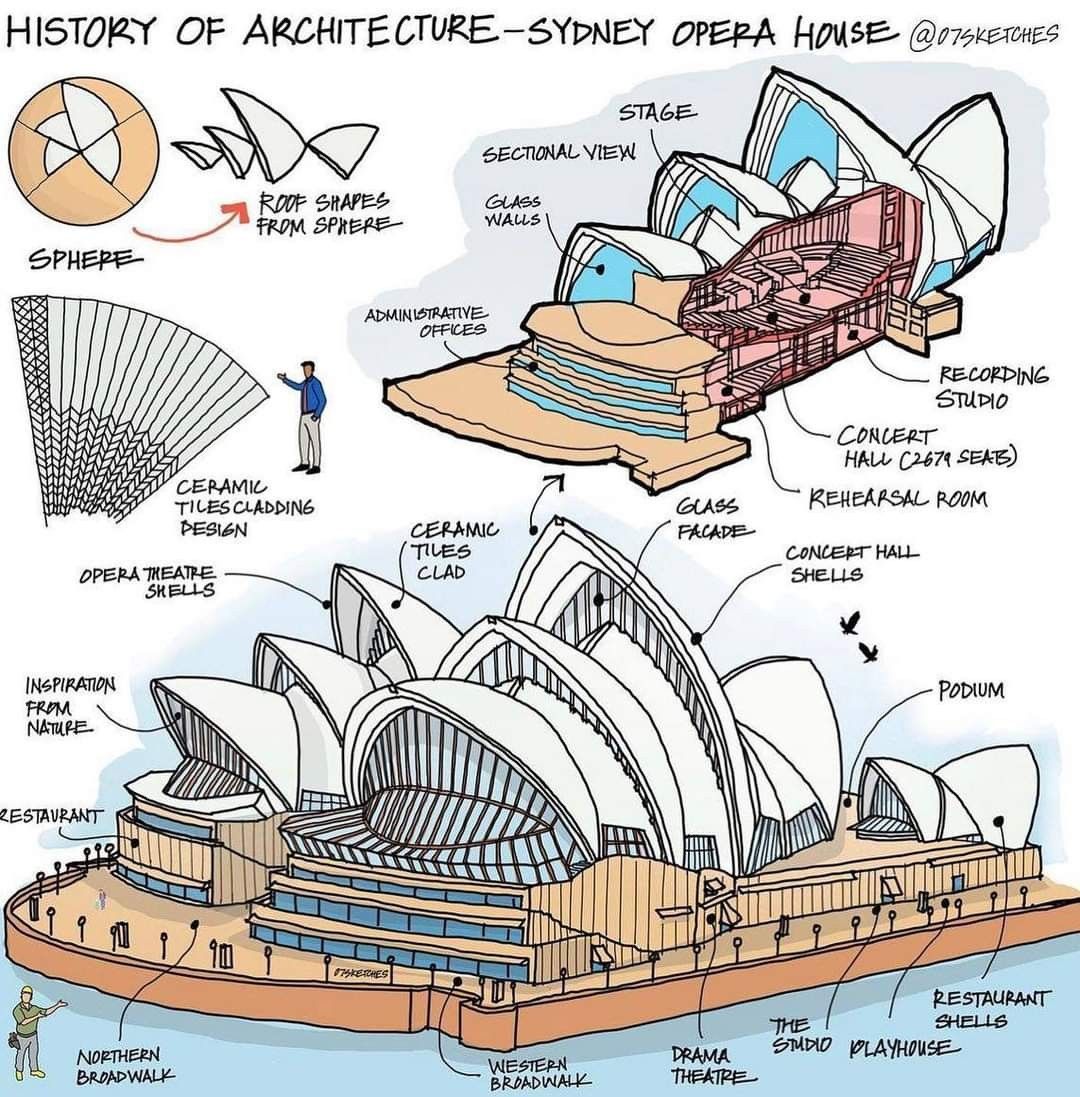From its sail-like shells to its world-class stages, the Sydney Opera House stands as a global symbol of creativity, engineering brilliance, and Australia’s cultural identity.
When people imagine the skyline of Sydney, their minds immediately conjure the unmistakable silhouette of the Sydney Opera House. With its gleaming white “sails” rising over the harbor, the building has become more than an opera house—it is a symbol of modern Australia, blending art, engineering, and nature in a breathtaking architectural masterpiece.
Completed in 1973 after years of challenges, delays, and political debates, the Sydney Opera House today represents not only visionary design but also the persistence of human creativity.
🌊 Inspiration from Nature
Danish architect Jørn Utzon designed the Opera House after winning an international competition in 1957. His concept drew inspiration from the natural world—the sails of ships in Sydney Harbour, seashells, and even sections of an orange.
The famous roof shells are actually derived from a single spherical form. By cutting sections from a sphere, Utzon was able to solve one of the most difficult engineering problems of the project: how to design the massive curved roof in a way that could actually be built.
This approach gave the Opera House not just its sculptural beauty but also structural feasibility.
🏛️ Architectural Marvel
The Sydney Opera House is much more than a single building—it is a complex of performance venues designed to accommodate diverse art forms.
Key architectural features include:
- Concert Hall: The largest performance space, with over 2,600 seats, renowned for its acoustics.
- Opera Theatre Shells: Shaped to resemble sails, housing opera and ballet performances.
- Drama Theatre and Playhouse: Spaces designed for smaller, more intimate productions.
- The Studio: A flexible venue for experimental and contemporary performances.
- Ceramic Tile Cladding: The roof is covered with over 1 million glossy white tiles, giving the Opera House its shimmering effect under the Australian sun.
- Glass Facades: Allow breathtaking views of the harbor while connecting audiences with the surrounding landscape.
The integration of these design elements makes the building both functional and awe-inspiring.
🎶 More Than an Opera House
Despite its name, the Sydney Opera House is not limited to opera. It hosts:
- Symphony concerts
- Theatre plays
- Dance and ballet
- Film screenings
- Talks and exhibitions
With thousands of events each year, it welcomes over 8 million visitors annually, making it one of the busiest cultural centers in the world.
⚙️ Engineering Feat
The Opera House’s construction was no easy feat. The roof shells posed enormous engineering challenges that took years to resolve.
At one point, the project seemed impossible. Engineers struggled with how to build the complex curves until Utzon’s spherical solution emerged. Even then, the construction required new techniques in concrete casting and assembly, pushing the limits of mid-20th-century technology.
The podium base was completed first, but the roof structure delayed the project by years. Ultimately, what was supposed to take 4 years stretched to 14 years, with costs rising more than tenfold.
🏗️ A Controversial Journey
The Opera House was not built without drama. Disputes between Utzon and the New South Wales government led to his resignation in 1966—before the project was completed. Other architects finished the interiors, and Utzon never returned to see the completed building.
However, decades later, Utzon’s contribution was finally recognized, and he was awarded the Pritzker Architecture Prize in 2003. The jury declared the Sydney Opera House one of the greatest buildings of the 20th century.
🌍 UNESCO World Heritage
In 2007, the Sydney Opera House was designated a UNESCO World Heritage Site, recognized as “a masterpiece of 20th-century architecture.” Its global significance lies not only in its design but also in the way it represents the fusion of creativity and technical achievement.
🌟 Cultural Impact
For Australians, the Opera House is more than just a landmark. It is a national icon, much like the Eiffel Tower is for Paris or the Statue of Liberty for New York.
It has also become a global stage. From hosting legendary performances by artists like Luciano Pavarotti and Beyoncé, to serving as the backdrop for international celebrations such as New Year’s Eve fireworks, the Opera House connects Sydney with the world.
♻️ Sustainability and the Future
The Opera House has also embraced modern challenges. Sustainability initiatives have been introduced, including energy-efficient lighting, solar power, and water recycling systems. The goal is to ensure that this cultural gem remains as environmentally responsible as it is beautiful.
Future plans include continued renovations to improve acoustics, accessibility, and audience experience while preserving Utzon’s original vision.
🎭 Living Architecture
What makes the Sydney Opera House extraordinary is that it is not a static monument—it is living architecture. Every performance breathes life into its sails, every visitor brings new energy, and every moment on its stage adds another note to the global symphony of culture.
From the northern and western broadwalks to the restaurants overlooking the harbor, the Opera House is a place where art, architecture, and everyday life converge.
🌟 Conclusion
The Sydney Opera House is more than an engineering triumph, more than a cultural venue, and more than an architectural wonder. It is a celebration of human imagination, a testament to what can be achieved when visionaries dream boldly, and societies dare to bring those dreams to life.
Over 50 years since its opening, it continues to inspire artists, architects, engineers, and millions of visitors worldwide. Its sails may rise from Sydney Harbour, but its impact reaches across the globe.
